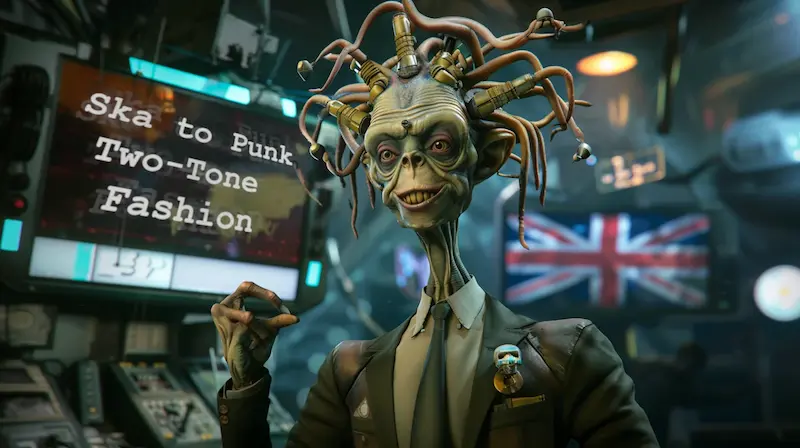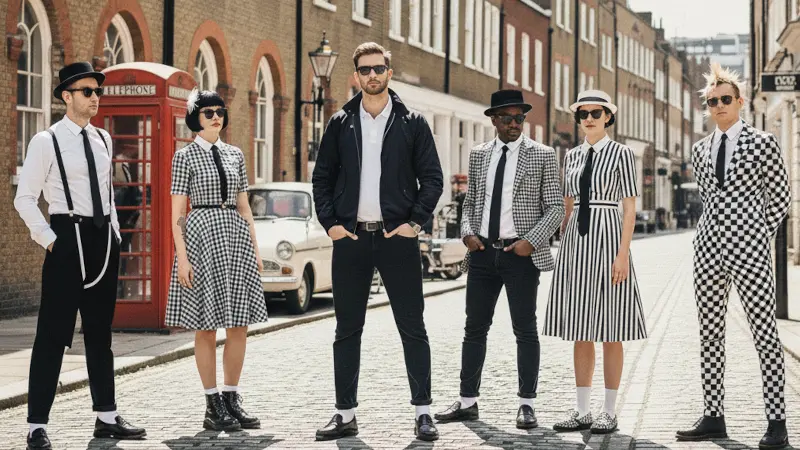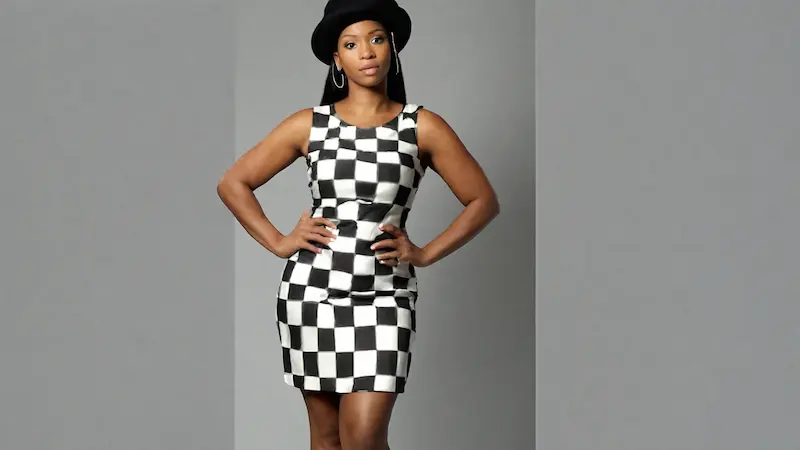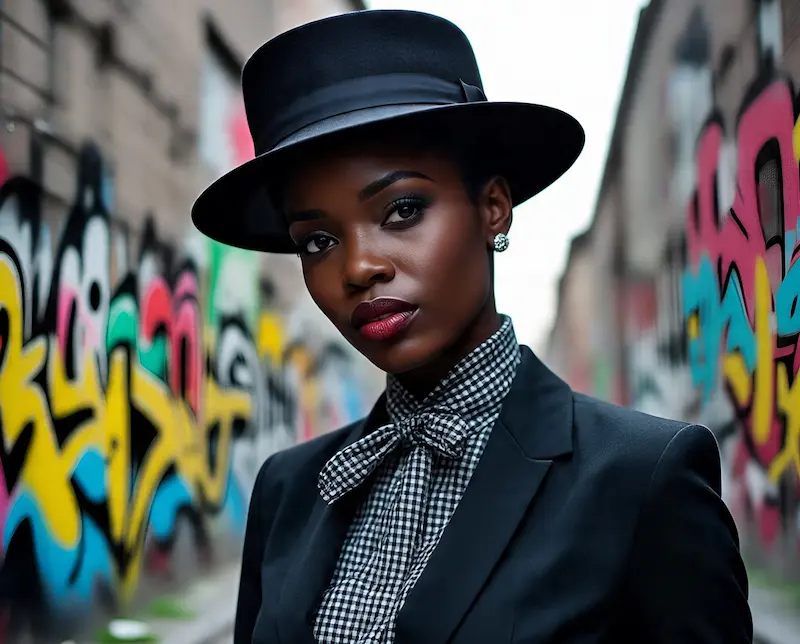
Two-Tone Fashion: Ska to Punk Style & Reggae Influence
Reggae’s rich cultural identity is just one of its many facets. Cultural identity is particularly noticeable in reggae fashion.
While Jamaica gave birth to the foundational rhythms and Rastafarian-inspired attire, the late 1970s in the United Kingdom saw a revolutionary fusion of sounds and styles that indelibly stamped its imprint on the Two-Tone movement, a new worldwide fashion trend.
This period was more than just music; it represented a cultural phenomenon where ska, reggae, punk, and mod styles merged, forming a unique aesthetic that still inspires today.
If you’re exploring the nuances of reggae fashion, understanding the Two-Tone fashion movement is absolutely essential.

The Genesis of a Style: Britain’s Social and Musical Melting Pot
By the late 1970s, Britain was a society grappling with economic hardship and racial tensions. The lively, unified sounds of 1960s Jamaican ska and reggae appealed to a new generation of musicians, many of whom came from multiracial backgrounds.
Punk rock’s raw energy, speed, and do-it-yourself mentality were mixed with catchy rhythms to produce a sound that was simultaneously fiercely modern and nostalgic.
The Specials’ Jerry Dammers and his 2 Tone Records label promoted this new genre, which came to be known as Two-Tone.
The music’s message was simple: diversity brings people together.
The accompanying Two-Tone fashion served as a visual manifestation of this potent message.
As a deliberate allusion to racial harmony, the phrase “Two-Tone” itself embodied the black and white checkerboard designs that came to represent the movement and the merging of different races and music genres.

The Core Elements of Two-Tone Fashion: A Study in Contrasts
The Two-Tone style was a deliberate blend, a sartorial bridge between different subcultures. It took the sharp, smart precision of 1960s Mod fashion, the cool, laid-back attitude of Jamaican rude boys, and the rebellious, anti-establishment edge of punk.
- Sharp Silhouettes and Tailoring: The influence of Mod and original rude boy fashion was undeniable. This meant a return to crisp, tailored lines, a stark contrast to the often baggy or distressed look of other contemporary youth styles.
- Two-Tone Suits: Often slim-fit, black or charcoal suits, sometimes with subtle checks or pinstripes, were a cornerstone. The original Jamaican “rude boy” style, which drew inspiration from American jazz and gangster movies, was honored in this way.
- Harrington Jackets: Providing a sophisticated yet laid-back substitute for bulkier coats, these lightweight, collared jackets became a classic outerwear piece for both men and women.
- Button-Down Shirts: Crisp white or light-colored shirts, often with narrow ties, completed the sharp upper half.
- The Black and White Motif: The movement’s most recognizable visual emblem was this eye-catching pattern. It was more than just a design decision; it was a powerful statement of solidarity and anti-racism. It would appear on everything from stage designs and album covers to ties and socks. 2 Tone fashion became instantly recognizable thanks to this striking, graphic element.
- Attitude-Driven Footwear:
- Doc Martens: Strong, frequently black, shiny Dr. Martens boots were a sensible but rebellious option, especially for people with a skinhead bent.
- Loafers & Brogues: Polished leather loafers or brogues were popular for a more sophisticated style, especially influenced by the Mod revivalists.
- White Socks: White socks, a small but crucial detail, frequently added a pop of contrast, especially when worn with black shoes, highlighting the two-tone look.
- Hair and Accessory Items:
- Short Haircuts: Short Haircuts: While punk often wore wild, colorful hair, two-tone fashion, especially among men, tended to favor neater, usually shorter haircuts that reflected Mod and original skinhead influences.
- Pork Pie Hats: Inspired by Jamaican ska and jazz performers, the pork pie hat was a popular item that added a touch of cool elegance.
Braces (Suspenders): Usually worn over shirts, these added a practical yet fashionable touch, especially if they were black and white.
Famous People and Their Impact on Two-Tone Fashion
The bands themselves were the ultimate fashion icons, establishing the styles that quickly became popular among young people.

- The Selecter: Starring Pauline Black, demonstrated how nasty girl attire utilized similar tailored features, often with a feminine touch, such as pencil skirts and elegant blouses, but always with that underlying sharp edge.
- The Specials: As pioneers, their monochromatic black suits, polished stage presence, and multiracial lineup perfectly embodied the Two-Tone fashion trend. They presented a polished, serious image that contrasted with the lighthearted tone of their songs.
- Madness: While perhaps leaning more into a slightly more flamboyant, “nutty boy” aesthetic, their early days were rooted in Two-Tone fashion, with members often seen in trilby hats, suits, and a quirky, slightly theatrical take on the look.
A new generation was inspired to embrace this blended look by these trailblazers who popularized two-tone clothing.

The Rude Boy and Rude Girl Legacy
The essence of the Jamaican rude guy and rude girl is important to Two-Tone fashion. These were the stylish, often rebellious youth of 1960s Jamaica who loved American R&B and dressed sharply.
When ska and reggae came to the UK, the rude boy persona, complete with crisp suits, slim ties, and a cool demeanor, struck a deep chord. By incorporating punk’s attitude and British working-class flare, the Two-Tone movement purposefully revitalized and recreated this style.
The rude boy fashion of the Two-Tone era’s crude boy style was a more sophisticated nod to its Jamaican forebears. It preserved an element of sophistication while adding a sense of rebellion against traditional norms, a consistent theme in both punk and reggae music. Similarly, rude girl fashion offered a strong, independent female image that was both stylish and empowered.

Subgenres and Style Variations After the First Wave
Although the first Two-Tone wave had a significant impact, it also had an impact on later subgenres and fashion trends:
- Ska Punk Fashion: The rude boy persona, complete with sharp suits, slim ties, and a cool demeanor, resonated deeply when ska and reggae arrived in the UK. The Two-Tone movement deliberately revived and recreated this style by fusing the British working-class flair with the attitude of punk.
- Skinhead Reggae Fashion: It’s important to note the complex relationship between Two-Tone and the skinhead subculture. While elements of the original 1960s skinhead style (Doc Martens, short hair, smart but casual attire) were absorbed by Two-Tone, the movement actively promoted anti-racism, distancing itself from the far-right factions that later appropriated skinhead imagery. Two Tone skinhead apparel reflected the music’s inclusive, anti-racist spirit.
Two Tone Streetwear: The effortless coolness and graphic simplicity of Two-Tone streetwear elements have consistently resurfaced in mainstream fashion. The precise lines, monochrome palettes, and checkerboard patterns are ageless and may be readily integrated into modern casual clothing.

The Enduring Influence and Modern Interpretations
The impact of Two-Tone fashion history extends far beyond its original era. Today, the ways in which this style has shaped modern aesthetics are evident:
- Modern Ska & Punk Revival Bands: Many contemporary bands in these genres continue to pay homage to the classic Two-Tone outfits and aesthetic, keeping the look alive for new generations.
- Streetwear and High Fashion: Designers often draw inspiration from subcultural movements, and the striking visual language of Two-Tone, particularly its use of bold black and white, frequently appears in collections. The blend of sharp tailoring with a rebellious edge remains eternally appealing.
- Everyday Style: Elements like the Harrington jacket, Doc Martens, and the checkerboard pattern have become ubiquitous, often worn by individuals unaware of their rich Two-Tone music fashion origins. Nonetheless, they possess the innate coolness that characterizes the fashion.
Whether it’s a carefully curated Two Tone dress for a themed event, a classic ska clothing piece like a Fred Perry polo, or simply a pair of checkerboard Vans, the Two-Tone style is remarkably versatile. It appeals to a market that values traditional tailoring, a strong counter-cultural ethos, and both heritage and rebellion.
Creating Your Own Two-Tone Style

Would you like to expand your wardrobe with this iconic style? Capturing the spirit, not just the costume, is crucial.
- Let’s start with the basics: A Harrington jacket, slim black pants or jeans, and a crisp button-down shirt are excellent places to start.
- Adopt contrast by thinking about dark and light or black and white. A two toned dress or a top with contrasting panels can also nod to the aesthetic.
- Accessorize with intent: A pork pie hat, a slender black tie, and polished Doc Martens or shoes are essential.
- Checkerboard Accents: A tie, socks, or even a subtle pattern on a shirt can bring in that signature 2 tone fashion element.
- Attitude is Key: Like reggae itself, Two-Tone fashion is about confidence, unity, and a refusal to conform.
A tribute to the power of fashion and music to create identity and make a statement, the Two-Tone clothing UK scene later expanded globally to include Two-Tone clothing USA and Two-Tone clothing Europe.
From Two-Tone ska clothing to Two-Tone punk fashion, it showed how diverse styles could converge into something entirely new and incredibly influential.
Whether you identify with the Two-Tone mod style, the Two-Tone skinhead style, or the original Two-Tone rude boy fashion, this movement offers a rich, layered history that continues to define a separate segment of reggae’s vast fashion legacy.
It’s a style of dressing that transcends fads and conveys a timeless message of defiance, community, and unrivaled coolness.

Conclusion
The Two-Tone fashion trend is a prominent illustration of reggae’s extensive cultural impact. It was a dynamic fusion that represented the social narratives and the fundamental unity of the music, not just a fleeting fad.
Two-Tone created a distinct visual language that fused the precise tailoring of rough boy fashion with the symbolic black-and-white patterns of unity, as well as the raw energy of punk and the crispness of mod.
Beyond its UK roots, this fashion movement expanded globally, influencing ska fashion and Two-Tone streetwear as well as inspiring numerous artists and subcultures.
We can better understand how music shapes identity and how cross-cultural interactions can result in something entirely unique when we comprehend the visual elements and historical underpinnings of Two-Tone fashion

